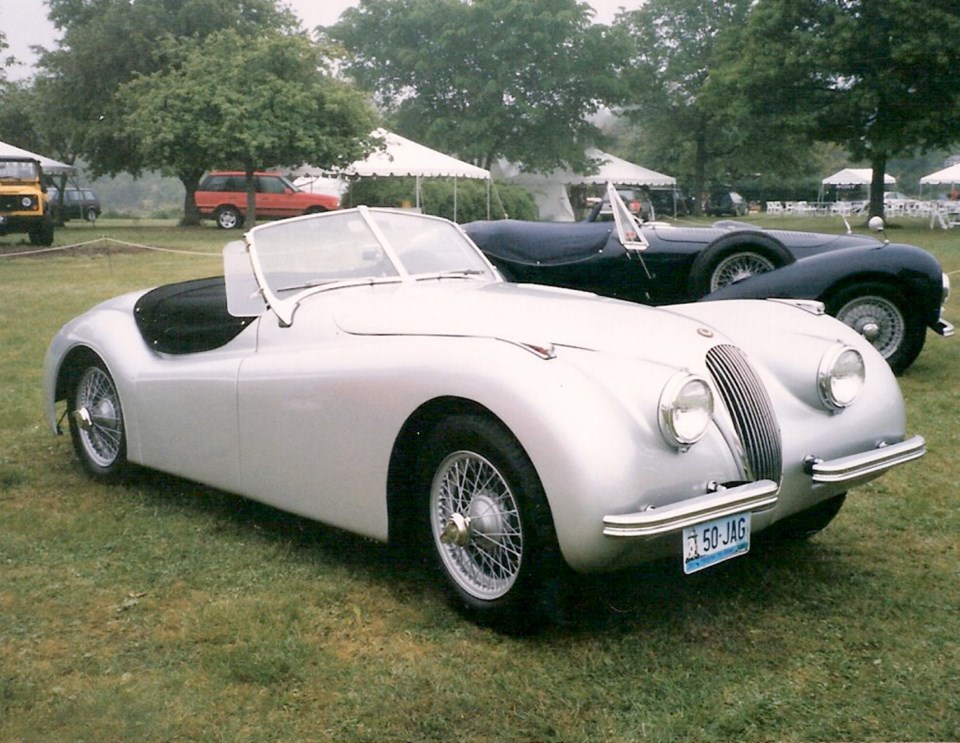When the new 1949 Jaguar XK120 was introduced at the 1948 Earls Court Motor Show in London, it was rotating majestically on a tilted platform. The impact on the crowd was electric.
The motoring world was stunned by this sleek graceful roadster with a twin-cam engine that promised the 120 mph (193 km/h) that inspired its name. And at a modest 1,275 pounds sterling, it was priced so low some skeptics predicted it would never come to market for that, or even wondered whether it would come at all.
It immediately became the most famous of the new British sports cars that arrived in the years following the Second World War.
Jaguar had built sports roadsters before the war, most notably the SS-100, but founder William Lyons felt a clean break with the past required an all-new postwar car. Chief engineer William Heynes led the mechanical design, while company co-founder Lyons did the styling.
The engineering specifications were daring. The engine developed 160 horsepower at a high 5,200 rpm, and its double overhead camshafts were a feature then usually found in racing cars.
Heynes created a 3.4-litre inline six with a massive crankshaft running in, seven generous main bearings and a surprisingly long stroke of 106 millimetres. Bore was 83 mm.
This twin-cam six was originally intended for a Jaguar sedan, but was installed in the roadster while the sedan was being readied. They called it the XK120 roadster, and it was so overwhelmingly impressive it was put into production. The intended sedan, the big Mark VII, arrived with the big six in 1951.
For the XK120 styling, Lyons created a long, sensuously flowing hood and fender line with headlamps nestled between hood and fenders. He added a delicate vertical bar grille, slender bumpers and rear fender skirts that gave full-length continuity of line. These skirts could not be used when centre-lock wire wheels were fitted because the knock-off hubs extended too far out.
Lyons and Heynes quickly capitalized on the good initial publicity. In May 1949, they took an XK to the famously straight and level Jabbeke highway in Belgium to test its performance. Fitted with an underpan and tonneau cover but without a windshield, the XK120 achieved a top speed of 213 km/h, making it the world’s fastest production car. In standard road trim it did 203.
Evidence of its durability was demonstrated in 1952 by an XK120 coupe (introduced in 1951) on a track in Montlhery, France. A team of crack drivers, including a young Stirling Moss, pounded the Jaguar continuously around Montlhery for seven solid days and nights. By week’s end, it had covered 27,148 km averaging 161 km/h, a remarkable demonstration of mechanical endurance.
While XK120s would be raced, it was intended as a touring car, not a racer. To prove its competition potential, Heynes developed the Jaguar C-Type, also called XK120C (“competition”) racing version. A team of three C-Types was entered in the 1951 Le Mans 24-hour race in France. One won the race at an average speed of 150 km/h, the first of five Le Mans Jaguar victories over the next seven years.
When the XK120 arrived in North America, it was equally impressive. Road & Track reported a top speed average of 196 km/h and zero to 100 km/h in 10.1 seconds. In the Florida Everglades, Tom McCahill of Mechanix Illustrated recorded zero to 100 in 9.0 seconds and a top speed of about 196 km/h.
There were some quality problems on the car Tom drove, however, and the forthright and humorous “Uncle Tom” reported them too. He called it “a rather crudely assembled job … put together like a Chinese laundryman’s version of a western sandwich … it would have been better if they had just shovelled the unassembled parts of the car I drove into an old bag and shipped them over parcel post.”
In spite of these imperfections, Tom was enthralled by the Jaguar, calling it “the world’s finest high-speed touring car.”
Although not meant for racing, many owners raced and rallied XKs and won several victories. An XK even became the first foreign car to win a NASCAR race. Fading brakes were its greatest competition weakness. Its steering was also heavy, although front torsion bars contributed to quite good handing.
In spite of some shortcomings, the XK120 Jaguar combined stupendous performance, stunning beauty and robust durability at a relatively reasonable price of under $5,000. During its model run from 1949 to 1954, when superseded by the XK140, 7,630 roadsters, 2,678 coupes and 1,769 convertibles were produced. The Jaguar XK120 is one of automotive history’s benchmark cars and a very desirable collectible.



